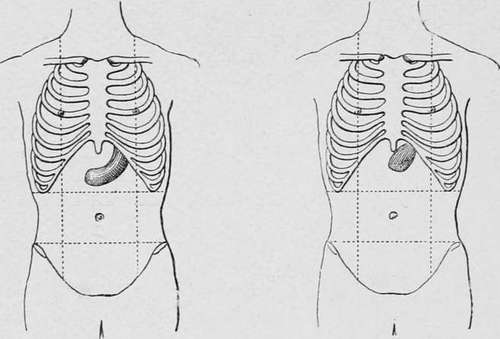Tumours Composed Of The Entire Stomach
Description
This section is from the book "Cancer And Other Tumours Of The Stomach", by Samuel Fenwick. Also available from Amazon: Cancer and other tumours of the stomach.
Tumours Composed Of The Entire Stomach
A palpable tumour may be formed by the entire stomach under two conditions : (a) Obstruction of the cardiac orifice with contraction of the empty viscus; (b) general infiltration of the gastric walls by the malignant growth.

Figs. 46, 47.-Showing the forms of tumour sometimes met with in cases of total infiltration of the stomach.
(a) It is only in rare cases that obstruction to the entry of food is followed by shrinkage of the stomach to such a degree that it can be felt as a round or somewhat elongated tumour in the left hypochondrium or contiguous portion of the epigastrium. In such cases the mass when grasped by the hand may sometimes be felt to harden and relax alternately. The normal outlines of the stomach cannot be defined, and the region usually occupied by the viscus is filled by the colon.
(b) General infiltration of the gastric walls may be accompanied by an oval or elongated tumour which projects from below the left costal margin into the epigastrium, and can often be grasped between the hands. The lower margin is usually hard and well defined, but the upper is indistinct, especially towards its left extremity. The surface is smooth or somewhat nodular, tender upon pressure, and comparatively dull on percussion. At first the whole mass moves with respiration, and can be displaced from side to side to the extent of an inch or more ; but with the progress of the complaint it often becomes fixed by peritoneal adhesions. Unlike other gastric tumours, it does not increase in size unless the omentum becomes infected, but, on the contrary, gradually grows smaller, harder, and more distinct. During the later stages of the complaint it is often obscured by ascites.
Continue to:
